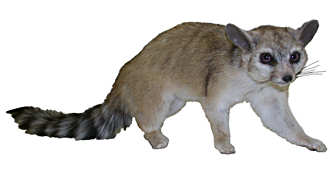 CENTENNIAL MUSEUM - CHIHUAHUAN DESERT
GARDENS—THE UNIVERSITY OF TEXAS AT EL PASO
CENTENNIAL MUSEUM - CHIHUAHUAN DESERT
GARDENS—THE UNIVERSITY OF TEXAS AT EL PASO
RINGTAIL
Cacomixtle norteño
Centennial Museum Collection 2006.8.6
Scientific name: Bassariscus astutus
Systematics
Class: Mammalia
Order: Carnivora
Family: Procyonidae
Description
From the Aztec Nahuatl, Cacomixtle means half mountain lion; whereas the scientific name comes from Greek bassara for fox, and the Latin iscus for little and astutus for cunning.
This member of the raccoon family can navigate limbs and ledges. Its tail is approximately the same length as the rest of its body (about 28 inches for an adult). At about 2.5 pounds, it is
sleek and compact with a pointed muzzle and whitish circles around large eyes. Its coat is tan-brownish-grey with black bands and tip on its tail. Fossils from late in the Miocene period
(ca. 9-6 million years old) are similar to the living species.
Distribution
Southwest Oregon, California, Nevada, Utah, Colorado, Arizona, New Mexico, Texas, and parts of northern Mexico. The Ringtail became the State Mammal of Arizona on 13 August 1986.
Home
Dens are narrow and padded with plant materials.
Diet
The diet is varied. This nocturnal mammal forces prey animals down with forepaws and delivers a killing bite to the throat and proceeding to devouring the head first.
Breeding
Occurs in late winter and early spring with litters of usually three born in May or June. In five or six weeks the eyes open and by fall the young have adult coloring, but not size, and can
hunt independently.
Defenses
Young ringtails squeak, but adults bark, snarl and scream. When threatened it also secretes a foul smelling secretion. Its chief predators are Bobcats, Coyotes, and Great Horned Owls.
Desert Diary
by Arthur Harris, Ph.D, Director, Laboratory for Environmental Biology,
The University of Texas at El Paso
Common names often are misleading or confusing. For example, depending on where you're from, "gopher" may mean a tortoise, a ground squirrel, or a pocket gopher. But sometimes, common names really are descriptive. "Ringtail" is one of these. A long, fluffy, and distinctively ringed tail is the hallmark of this graceful member of the family Procyonidae, a relative of the raccoon and the coati. Like other members of this family, Ringtails are omnivorous, a 50-cent word meaning that-like humans-they'll eat almost anything: fruit, insects, mice, eggs-you name it. They are, however, somewhat more predatory than their relatives. Inhabiting rocky canyon lands, they are constantly on the prowl during the night, inspecting every nook and cranny that might house a tasty mouse or beetle. Wonderfully adapted for their rugged terrain, they are agile climbers and jumpers, and even have hind feet that can turn 180 degrees, allowing them to safely descend vertical cliffs. Consider yourself lucky if you spot one of these shy denizens of the desert.
